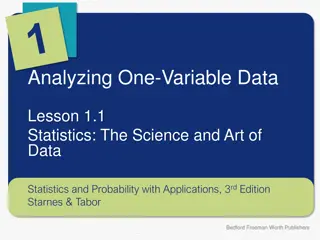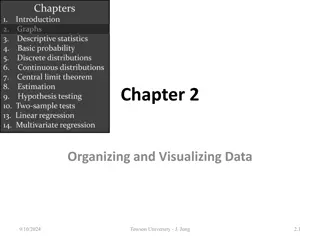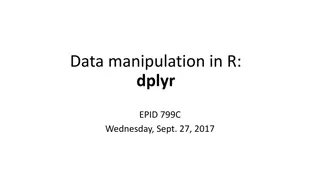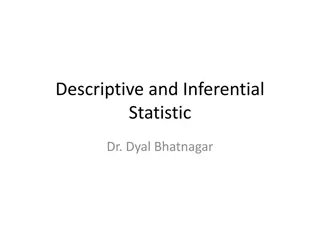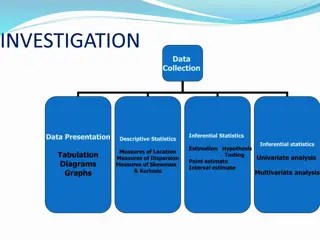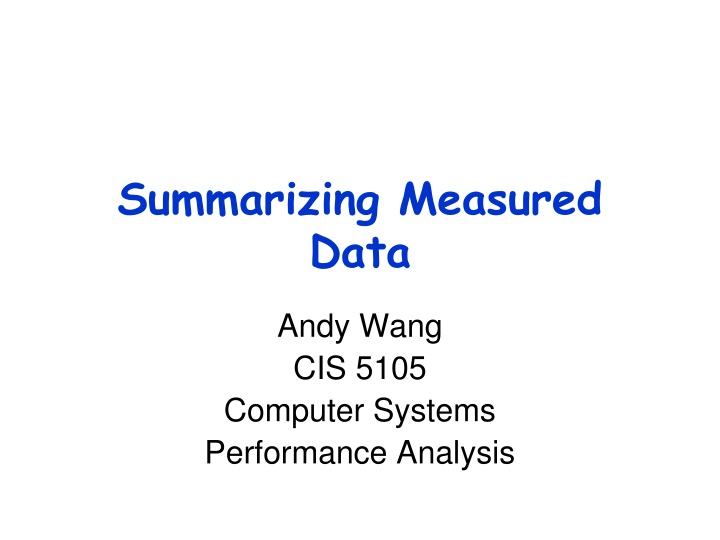
Statistics Essentials for Performance Analysis
Discover key statistical concepts like independent events, random variables, cumulative distribution functions, probability density functions, and probability mass functions essential for analyzing computer system performance.
Download Presentation

Please find below an Image/Link to download the presentation.
The content on the website is provided AS IS for your information and personal use only. It may not be sold, licensed, or shared on other websites without obtaining consent from the author. If you encounter any issues during the download, it is possible that the publisher has removed the file from their server.
You are allowed to download the files provided on this website for personal or commercial use, subject to the condition that they are used lawfully. All files are the property of their respective owners.
The content on the website is provided AS IS for your information and personal use only. It may not be sold, licensed, or shared on other websites without obtaining consent from the author.
E N D
Presentation Transcript
Summarizing Measured Data Andy Wang CIS 5105 Computer Systems Performance Analysis
Introduction to Statistics Concentration on applied statistics Especially those useful in measurement Today s lecture will cover 15 basic concepts You should already be familiar with them
1. Independent Events Occurrence of one event doesn t affect probability of other Examples: Coin flips Inputs from separate users Unrelated traffic accidents What about second basketball free throw after the player misses the first?
2. Random Variable Variable that takes values probabilistically Variable usually denoted by capital letters, particular values by lowercase Examples: Number shown on dice Network delay
3. Cumulative Distribution Function (CDF) Maps a value a to probability that the outcome is less than or equal to a: ( ) ( x a x P a F = ) Valid for discrete and continuous variables Monotonically increasing Easy to specify, calculate, measure
CDF Examples Coin flip (T = 0, H = 1): 1 0.5 0 0 1 2 3 Exponential packet interarrival times: 1 0.5 0 0 1 2 3 4
4. Probability Density Function (pdf) Derivative of (continuous) CDF: x dF x f ) ( = ( ) dx Usable to find probability of a range: = P ( x x x ) F ( x ) F ( x ) 1 2 2 1 x = 2 f ( x ) dx x 1
Examples of pdf Exponential interarrival times: 1 0 0 1 2 3 Gaussian (normal) distribution: 0.45 0.4 0.35 0.3 0.25 0.2 0.15 0.1 0.05 0 -3 -2 -1 0 x 1 2 3
5. Probability Mass Function (pmf) CDF not differentiable for discrete random variables pmf serves as replacement: f(xi) = pi where piis the probability that x will take on the value xi = ( ) ( 2 1 F x x x P ) ( ) x F x 2 1 x = p i x x 1 2 i
Examples of pmf 1 Coin flip: 0.5 0 0 1 Typical CS grad class size: 0.5 0.4 0.3 0.2 0.1 0 4 5 6 7 8 9 10 11
6. Expected Value (Mean) n = i Mean (mu) = = = E ( x ) p x xf ( x dx ) i i 1 Summation if discrete Integration if continuous
7. Variance n = i Var(x) = = 2 2 E [( x ) ] p ( x ) i i 1 + = 2 ( x ) f ( x dx ) i Often easier to calculate equivalent 2 2 ) ( ) ( x E x E Usually denoted 2; square root (sigma) is called standard deviation
8. Coefficient of Variation (C.O.V. or C.V.) Ratio of standard deviation to mean: = C.V. Indicates how well mean represents the variable Does not work well when 0
9. Covariance Given x, y with means xand y, their covariance is: ) , ( Cov y x xy = = = 2 E [( x )( y )] x y E ( xy ) E ( x ) E ( y ) High covariance implies y departs from mean whenever x does
Covariance (contd) For independent variables, E(xy) = E(x)E(y) so Cov(x,y) = 0 Reverse isn t true: Cov(x,y) = 0 doesn t imply independence If y = x, covariance reduces to variance
10. Correlation Coefficient Normalized covariance (rho): 2 ??? ???? ??????????? ?,? = ???= Always lies between -1 and 1 Correlation of 1 x ~ y, -1 ~ x y
11. Mean and Variance of Sums For any random variables, ( 2 2 1 1 E a x E a + = + + + E a x a x a x ) + k + k ( ) ( x ) a E ( x ) 1 1 2 2 k k For independent variables, ( Var 1 1 x a = + + + a x a x a x ) 2 + 2 a k k 2 1 2 2 + + 2 k Var ( ) V ar ( x ) a V ar ( x ) 1 2 k
12. Quantile x value at which CDF takes a value is called -quantile or 100 -percentile, denoted by x . = ) ( ) ( x F x x P = If 90th-percentile score on GRE was 162, then 90% of population got 162 or less
Quantile Example 1.5 1 0.5 0 0 2 0.5-quantile -quantile
13. Median 50th percentile (0.5-quantile) of a random variable Alternative to mean By definition, 50% of population is sub- median, 50% super-median Lots of bad (good) drivers Lots of smart (not so smart) people
14. Mode Most likely value, i.e., xi with highest probability pi, or x at which pdf/pmf is maximum Not necessarily defined (e.g., tie) Some distributions are bi-modal (e.g., human height has one mode for males and one for females) Can be applied to histogram buckets
Examples of Mode Mode 0.2 Dice throws: 0.1 0 2 3 4 5 6 7 8 9 10 11 12 Mode Adult human weight: Sub-mode
15. Normal (Gaussian) Distribution Most common distribution in data analysis pdf is: 1 ) ( 2 ( x ) = 2 f x e 2 2 - x + Mean is , standard deviation
Notation for Gaussian Distributions Often denoted N( , ) Unit normal is N(0,1) If x has N( , ), has N(0,1) x The -quantile of unit normal z ~ N(0,1) is denoted z so that x z = + = P ( ) z P ( x )
Why Is Gaussian So Popular? We ve seen that if xi ~ N( , ) and all xi independent, then ixi is normal with mean i i and variance = i2 i2 Sum of large no. of independent observations from any distribution is itself normal (Central Limit Theorem) Experimental errors can be modeled as normal distribution.
Summarizing Data With a Single Number Most condensed form of presentation of set of data Usually called the average Average isn t necessarily the mean Must be representative of a major part of the data set
Indices of Central Tendency Mean Median Mode All specify center of location of distribution of observations in sample
Sample Mean Take sum of all observations Divide by number of observations More affected by outliers than median or mode Mean is a linear property Mean of sum is sum of means Not true for median and mode
Sample Median Sort observations Take observation in middle of series If even number, split the difference More resistant to outliers But not all points given equal weight
Sample Mode Plot histogram of observations Using existing categories Or dividing ranges into buckets Or using kernel density estimation Choose midpoint of bucket where histogram peaks For categorical variables, the most frequently occurring Effectively ignores much of the sample
Characteristics of Mean, Median, and Mode Mean and median always exist and are unique Mode may or may not exist If there is a mode, may be more than one Mean, median and mode may be identical Or may all be different Or some may be the same
Mean, Median, and Mode Identical Median Mean Mode pdf f(x) x
Median, Mean, and Mode All Different pdf f(x) Mode Mean Median x
So, Which Should I Use? If data is categorical, use mode If a total of all observations makes sense, use mean If not, and distribution is skewed, use median Otherwise, use mean But think about what you re choosing
Some Examples Most-used resource in system Mode Interarrival times Mean Load Median
Dont Always Use the Mean Means are often overused and misused Means of significantly different values Means of highly skewed distributions Multiplying means to get mean of a product Example: PetsMart Average number of legs per animal Average number of toes per leg Only works for independent variables Errors in taking ratios of means Means of categorical variables
Example: Bandwidth Experiment number File size (MB) Transfer time (sec) Bandwidth (MB/sec) 1 2 20 20 1 2 20 10 What is the average bandwidth? (20 MB/sec + 10 MB/sec)/2 = 15 MB/sec ???
Example: Bandwidth Experiment number File size (MB) Transfer time (sec) Bandwidth (MB/sec) 1 2 20 20 1 2 20 10 When file size is fixed Average transfer time = 1.5 sec Average bandwidth = 20 MB / 1.5 sec = 13.3 MB/sec (11% difference!) Another way (20MB + 20MB)/(1 sec + 2 sec) = 13.3 MB/sec
Example 2: Same Bandwidth Numbers Experiment number File size (MB) Transfer time (sec) Bandwidth (MB/sec) 1 2 60 20 3 2 20 10 (60MB + 20MB)/(3 sec + 2 sec) = 16 MB/sec
Example 2: Bandwidth Experiment number File size (MB) Transfer time (sec) Bandwidth (MB/sec) 1 2 20 60 1 6 20 10 (60MB + 20MB)/(1 sec + 6 sec) = 11 MB/sec
Geometric Means An alternative to the arithmetic mean ( i 1 = ) / 1 n n = x ix Use geometric mean if product of observations makes sense
Good Places To Use Geometric Mean Layered architectures Performance improvements over successive versions Average error rate on multihop network path
Harmonic Mean Harmonic mean of sample {x1, x2, ..., xn} is n x 1 1 2 1 = 1 + + + x x n x Use when arithmetic mean of 1/x1 is sensible
Example of Using Harmonic Mean When working with MIPS numbers from a single benchmark Since MIPS calculated by dividing constant number of instructions by elapsed time m ti xi = Not valid if different m s (e.g., different benchmarks for each observation)
Another Example of Using Harmonic Mean Bandwidth from a given benchmark Constant number of bytes (B) divided by varying elapsed times (t1, t2 ) B/t1, B/t2, We really want to average the times first T = (t1 + t2 .)/n Then compute the bandwidth B/T = Bn/(t1 + t2 ) = n/(t1/B + t2/B .)
Means of Ratios Given n ratios, how do you summarize them? Can t always just use harmonic mean Or similar simple method Consider numerators and denominators
Considering Mean of Ratios: Case 1 Both numerator and denominator have physical meaning Then the average of the ratios is the ratio of the averages
Example: CPU Utilizations Measurement Duration 1 1 1 1 100 Sum Mean? Busy (%) 40 50 40 50 20 200 % CPU
Mean for CPU Utilizations Measurement Duration 1 1 1 1 100 Sum Mean? Busy (%) 40 50 40 50 20 200 % Not 40% CPU
Properly Calculating Mean For CPU Utilization Why not 40%? Because CPU-busy percentages are ratios So their denominators aren t comparable The duration-100 observation must be weighted more heavily than the duration-1 observations





